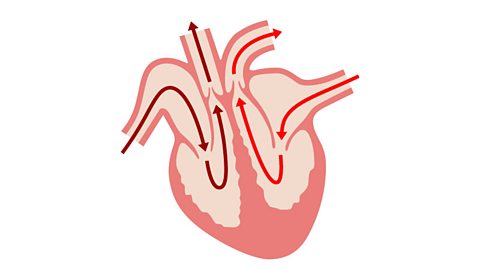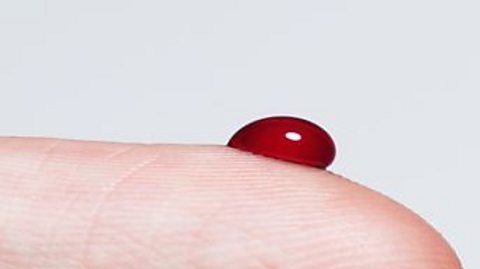Key points
- Respiration is a chemical reaction which takes place in all livings cells and releases energy from glucose.
- Anaerobic respiration occurs without oxygen and releases less energy but more quickly than aerobic respiration.
- Anaerobic respiration in microorganisms is called fermentation
Types of respiration
respirationA chemical reaction that occurs in the mitochondria of cells in which glucose and oxygen react to produce carbon dioxide and water, releasing energy. is a chemical reaction which occurs in every one of the cells in the human body and all cells on the entire planet. Remember, respiration is not the same as breathing. The scientific name for breathing is 'ventilationThe process of breathing. Breathing in is called inhaling, breathing out is called exhaling.'.
Respiration releases energy stored in glucose and without it these cells would die. There are two types of respiration:
- Aerobic respiration occurs in the presence of oxygen and in most cells most of the time.
- Anaerobic respiration occurs without oxygen and much less frequently than aerobic respiration.
Human bodies use both types of respiration. Humans do aerobic respiration unless they are short of oxygen when they switch to anaerobic respiration.
Aerobic respiration occurs in mitochondriaTiny parts of cells floating in the cytoplasm where energy is released from glucose. The glucose comes from food. which are found in the cytoplasmThe liquid that makes up most of the cell in which chemical reactions happen. This is mainly water.. Cells which need more energy eg sperm cells which swim or muscle cells which contract and relax have more mitochondria.
Other organisms such as bacteria and yeast do a different version of anaerobic respiration called fermentationAnaerobic respiration which occurs in yeast and bacteria in which glucose is broken down into alcohol (ethanol) and carbon dioxide, releasing energy.
Video - When does anaerobic respiration take place?
A case study video on how an athlete uses anaerobic respiration during exercise
Anaerobic respiration is when an athlete is exercising too vigorously there’s not enough oxygen delivery into the muscle. So what happens is that the glucose is reacting and there’s a by-product from that which is called lactic acid.
Anaerobic respiration’s good for 100 metre sprints, 200 metre sprints, rugby - short bursts of speed, football - short bursts of speed.
Can you answer these questions based on the video?
1. What is missing when anaerobic respiration occurs?
2. What is the product of anaerobic respiration in humans?
Oxygen.
Lactic acid.
Anaerobic respiration in humans
During vigorous exercise your body cells may not have enough oxygen for aerobic respiration to take place and anaerobic respiration occurs instead.
The equation for this is:
glucose ‚Üí lactic acid
Anaerobic respiration releases less energy than aerobic respiration but it does this more quickly. The product of this reaction is lactic acid. This builds up in muscles causing pain and tiredness, which can lead to cramp.
After you finish vigorous exercise you continue to breathe deeply and quickly for a short period. This is called excess post-exercise oxygen consumption or EPOC. It used to be called ‘oxygen debt.’ During this time the lactic acid reacts with oxygen to form carbon dioxide and water, and releases the rest of the energy originally in the glucose.
Anaerobic respiration activity
Play this game to see how anaerobic respiration works in the body of a long-distance runner.
Anaerobic respiration in bacteria and fungi

Some bacteria and fungi such as yeast complete their own version of anaerobic respiration called fermentation. This is the equation:
glucose ‚Üí ethanol + carbon dioxide
Yeast undergoes fermentation when bread and beer is made. Ethanol is the alcohol produced. This is evaporated away when bread is baked. Carbon dioxide gas trapped in bread makes it rise and gives beer its bubbles.

Video - Fermentation
Gethin: So we're going to be thinking like biologists today, but what specifically are we delving into?
Mr Shribman: So this is a really weird part of biology. It's kind of the story of how we started adding mould and bacteria to food on purpose, to try to make it more delicious. If you've ever felt… if you've ever smelt that cheesy foot smell, that's literally the same mould used to make a lot of mouldy cheeses.
Anyway, today is mainly about the moulds and bacteria we use to make more delicious things than mouldy feet - things like bread and yoghurt.
Gethin: Yeah, really chosen a lovely, tasty subject to start us off with today, haven't you?
Mr Shribman: Yeah, so the mould we use to make bread is yeast. You can get yeast as a dried powder or you can also grow your own yeast in a jar to make the most delicious bread. I gave my mum a yeast culture, and she hated it because it kept bubbling over. So I named it after her, so she has to like it.
To work its magic, yeast does a process called anaerobic respiration. We sometimes call it fermentation too.
That's explained in this video coming up.
VOICEOVER: Anaerobic respiration in micro-organisms.
All living cells respire. It's the process that releases the energy stored in glucose for life processes, such as growth. Unlike aerobic respiration, oxygen is not necessary for anaerobic respiration to take place.
In micro-organisms such as yeast, a uni-cellular (or single cell) fungi, the process of anaerobic respiration is called fermentation. Ethanol, a type of alcohol, and carbon dioxide are produced during this process.
The word equation for fermentation is glucose produces ethanol and carbon dioxide. This ethanol, or alcohol, is useful for brewing beer and wine making. And the carbon dioxide is useful in baking because it helps bread to rise.
Gethin: Mr Shribman, what are we doing now, then?
Mr Shribman: So it's kind of rude what we do to yeast. We feed it and we bring it to life, and then we take away all its oxygen so that it has to do this instead of normal respiration.
Gethin: What is this?
Mr Shribman: Glucose plus nothing - cos we don't give it any oxygen - has to make ethanol and carbon dioxide.
Gethin: OK, what happens after this, then?
Mr Shribman: So the ethanol, also known as alcohol, and carbon dioxide is what's left over when yeast has done this process. So the carbon dioxide makes the bubbles in bread. If you get a piece of bread with a huge bubble in it, I like to think that's where really enthusiastic yeast was doing its stuff.
This whole process doesn't make much energy for the yeast. But if there's no oxygen, it's all they can do.
Gethin: OK, so why does yeast - or yeast fungus, should I say - make alcohol for us?
Mr Shribman: Well, yeast have got our backs, I suppose.
Actually, they don't really like making alcohol. They only make it if they have to because there's no oxygen about. Alcohol is poisonous to yeast. So if they make too much of it, they'll die. On the bright side, they make delicious foods while they're at it.Fermentation happens across loads of different fungi and bacteria, not just yeast.
Gethin: Yeah, well, I'm not complaining if it makes bread and yoghurt. But anyway, let's put your knowledge now then to the test with a quiz. I know you've got a quiz for us, Mr Shribman, so it's over to you. What are we going to be doing?
Mr Shribman: OK, so this is a really syllabus-based quiz and we're going to throw in some harder questions too.
Gethin: Right, harder questions too. Let's see how we get on. Good luck to you at home. Let's have the first question.
Mr Shribman: Quiz time.
Question number one. What are the conditions required for anaerobic respiration?
A) Plenty of oxygenB) Lack of oxygenC) Plenty of water
Gethin: What are you thinking? A, B or C? Based on what you've just been talking about, I'm going to say B, lack of oxygen.
Mr Shribman: That is correct.
Gethin: It's a good start.
Mr Shribman: Very nice!
OK, so the next question is… Which of these is a product of anaerobic respiration in human muscle cells?
So this isn't something we covered today. So…
A) Carbon dioxideB) EthanolC) Lactic acid
Gethin: I'm just going to say from training and how I feel after… when I work out, is it C, lactic acid?
Mr Shribman: It is C, lactic acid.
Can you answer these questions based on the video?
1. Give an example of a food that uses the fermentation process when it's being made.
2. What is produced in fermentation?
Bread, yoghurt, beer, wine.
Ethanol and carbon dioxide.
Test your knowledge
Quiz
Test questions
Write a paragraph to answer the following question. Tap 'Show answer' to see five points you could have included.
Explain why beer contains alcohol but bread doesn't.
- Both bread and beer are made by anaerobic respiration in microorganisms.
- This is also called fermentation.
- The formula for this is glucose ‚Üí ethanol + carbon dioxide.
- Bubbles in bread and beer are made by the carbon dioxide.
- Unlike beer, bread is baked which kills the yeast and evaporates the alcohol.
Teaching resources
Looking for more teaching resources? This short video clip offers a look at respiration and a tour around the circulatory system and digestive system in the human body, through blood vessels and into mitochondria.
91»»±¨ Teach has thousands of free, curriculum-linked resources to help deliver lessons - all arranged by subject and age group.
Play the Atomic Labs game! gamePlay the Atomic Labs game!
Try out practical experiments in this KS3 science game.

More on Respiration and gas exchange
Find out more by working through a topic
- count5 of 13

- count6 of 13

- count8 of 13
